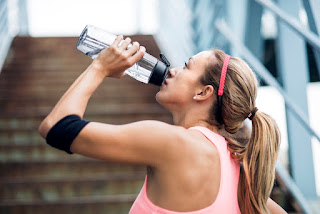Summertime Fitness: A Short Guide to Pursuing Your Fitness
Goals Over The Summer Months
When it
comes to exercising in the summer, there are several key factors to take into
account when planning your workout:
1)
Hydration Status
2)
Electrolyte & Salt levels
3)
Exercise Clothing & UV Radiation
4)
Weather & Other Environmental Factors
A good table to refer to when
considering your hydration status
can be found below. In it you can see that a well-hydrated state in one in
which your body weight is between -1% to 1% of what it was when you began
exercising. Remember, unless you are burning 3500+ calories during your workout
(you aren’t), the pounds of weight you’re losing are almost entirely water.
Losses in body fat occur on a larger time scale, so keep your body weight
normalized during your workout and focus on net-deficits in body weight over
periods of weeks.
% Body Weight
Change
|
|
Well Hydrated
|
-1 to +1 %
|
Minimal Dehydration
|
- 1 to -3%
|
Significant Dehydration
|
-3 to -5%
|
Serious Dehydration
|
-5%
|
Figure 1 –
Hydration level scaled to body weight
changes during a workout
That said, if you’re training hard and building muscle mass
your overall body weight may not change (or potentially increase) while your
body composition transitions to a more lean state. Base your progress on how
you feel and perform, not the number on the scale. This will help motivate you
to stay hydrated, have more effective workouts, and look better in the grand
scheme. As long as you’re not thirsty, you should be in the well-hydrated zone
so drink reasonable amounts of water throughout your workouts.
Related to
hydration status are your electrolyte
and salt levels, which will inevitably change over the course of a hard
summer workout. Electrolytes are vital elements for the initiation and
propagation of the electrical impulses that enable your muscles to contract and
relax. The utilization of those electrolytes by your muscle cells during
exercise, combined with the loss of sodium through sweat, contribute to
disturbance in one’s electrolytic balance over the course of a long session.
These disturbances are greatly amplified in hot environments where rates of
water loss via sweating are increased. Therefore it is incredibly important to
replenish those electrolytes actively throughout your workout to prevent
cramping and decrements in performance. A balanced electrolytic formula helps
in this endeavor. If this is unavailable to you, simply consuming a fluid with
sodium and potassium will help.
The physical qualities of the
environment during the summer months are such that the style of your exercise clothing will have to change by
necessity in order for you to maximize your training efficiency, especially
when exercising outdoors. Because increases in heat will increase your core
body temperature, your body will respond by increasing your breathing and
sweating rates in order to shed that excess heat. The most effective way your
body can shed heat is through evaporation. When exercising, your superficial peripheral
capillaries will dilate so that more blood will circulate close to the surface
of your skin. The blood in these capillaries contains heat, which is
transferred to the surface of your body through direct conductance. The less
material you’re wearing, the more effectively your body will be able to lose
that heat through the evaporation of sweat. Layers (particularly of the
non-sweat wicking variety) trap sweat on the surface of the skin and prevent
evaporation from occurring, leaving you overheated and compromising your
performance capacity.
An
important variable to consider when ditching the layers is sunlight and UV radiation. Remember to use
appropriate amounts of high SPF sunscreen to prevent burning if you’re working
outside on a sunny day. You can also limit your sun exposure by exercising in
the shade.
With the
high pressure and heat of summer comes the inevitable volatility in weather systems that may affect your
workout. Some factors to consider include rain, lightning, dry air, extreme
heat, and air pollutants. It is important to monitor weather reports so that
you are aware of changes in these variables that may impact your workout. While
it’s fine to exercise in the rain, remember to wear clothes that are water
resistant/repellant so that you don’t have to perform in damp, soggy clothing
or shoes. If there’s lightning in the mix, take that workout inside. Hydration
and electrolyte supplementation become extremely important in conditions of dry
air and extreme heat so bring extra water and a balanced electrolytic formula
to sip on. If there are high levels of dense air pollutants and particulate
matter, protect your lungs by working out indoors or on forested trails where
exposure to urban contaminants is limited.
Summer is a
great time to exercise outdoors! Just remember to pay attention to the
conditions of your environment and prepare accordingly to optimize the efficacy
of your training and maximize your results.
– Bobby













0 comments:
Note: only a member of this blog may post a comment.